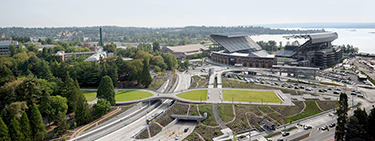|
Subscribe / Renew |
|
|
Contact Us |
|
| ► Subscribe to our Free Weekly Newsletter | |
| home | Welcome, sign in or click here to subscribe. | login |
Architecture & Engineering
| |
May 25, 2016
Montlake Triangle/Rainier Vista wins top award
Montlake Triangle and Rainier Vista, which connect the University of Washington campus with Sound Transit's new light rail station, won top honors as an outstanding local civil engineering achievement from the American Society of Civil Engineers.
This is the 16th year that the Seattle Section of ASCE has recognized projects that improve the quality of life and contribute to economic development in the region.
Here are the projects that won honor awards: Windermere combined sewer overflow reduction in Seattle in the water resources category; Ivar's Pier 54 seismic upgrades and renovation in Seattle, structures category; and Tiger Mountain Lower High Point Bridge in Issaquah, small project category.
ASCE Seattle will present the awards June 8 at Mirabella in Seattle.
Montlake Triangle/Rainier Vista won in the transportation and development category. ASCE said in a press release that the structure creates a seamless, grade-separated, multimodal transportation hub while improving the main gateway to the UW and completing the Olmstead Brothers' historic vision for the campus.
The hub brings together Link light rail, the Burke Gilman Trail, Metro buses, UW Medical Center and Husky Stadium.
The project team is KPPF Consulting Engineers, Gustafson Guthrie Nichol, Sellen/Merlino JV and Shannon & Wilson. UW is the owner.
Here are some of the challenges the team faced:
• 19,000 cubic yards of fill were added above a 30-year old parking garage to restore the historic view corridor to Mount Rainier. ASCE said it could be the largest earthwork project over a building. Fill depths ranged from 18-inches to 10-feet.
• An innovative 3D post-tensioning system was used to give the land bridge its signature hourglass shape.
• One side of an underground parking garage was exposed when a street was lowered by 19 feet for the land bridge. This required doing seismic retrofits on the garage while it was open.
• Complex geometric constraints were resolved to create safe, accessible and efficient pathways, including for the Burke-Gilman Trail.
For the Windermere CSO project, Seattle Public Utilities constructed a 2.05-million-gallon storage facility and two system retrofits. The storage tank was designed to minimize impacts to nearby Magnuson Park and future development.
Work also included 2,250 linear feet of conveyance piping, controls, and mechanical and odor control equipment. Retrofits consisted of a new modulating combined sewer control gate, improvements to existing weirs, addition of instrumentation for level and flow measurement, and real-time monitoring and controls.
The project team is HDR, CH2M, CDM Smith and HBB Landscape Architects.
On Ivar's Pier 54, Reid Middleton did structural engineering for the renovation. Work included replacing timber aprons on the north and west sides of the building and replacing part of the south apron with new steel piling, precast concrete caps and deck panels.
Aprons were designed to seismically strengthen the rest of the timber pier that supports the building.
The nearly 100-year-old heavy timber restaurant on the pier was also seismically renovated, with steel moment frames and truss upgrades.
The project team also included Hikari Consulting, Mithun, CB Anderson Architects, RS Consulting, GeoEngineers, W.G. Clark Construction Co. and Pacific Pile & Marine.
The Tiger Mountain project involved building a 200-foot-long, self-weathering, steel truss, pedestrian bridge 30 feet above Lower High Point Creek to replace a wooden bridge that was damaged by flooding in 2009.
The new bridge is only 4 feet, 6 inches wide, and the height of intermediate piers is 30 feet. The superstructure is a 4-foot-10-inch pony truss, with the top chord of the truss also working as the top of the railing to save the cost in installing separate railings. The bridge deck is treated timber. Two intermediate columns are made of curved 12-inch square steel tubes.
The spread footings, column pedestals and abutments are cast-in-place concrete. Foundations were laid outside of potential geological hazard areas.
Washington State Department of Natural Resources owns the project. The team includes RHC Engineering and Shannon & Wilson.



